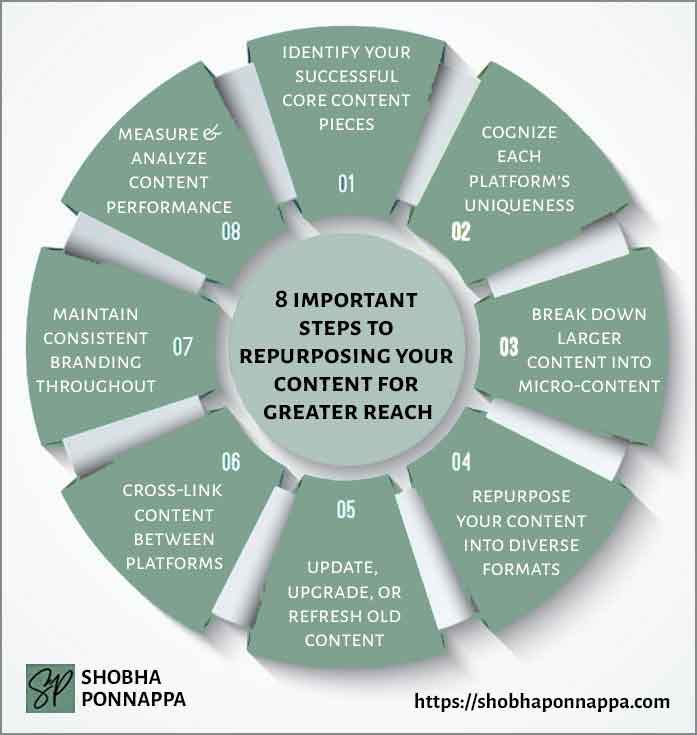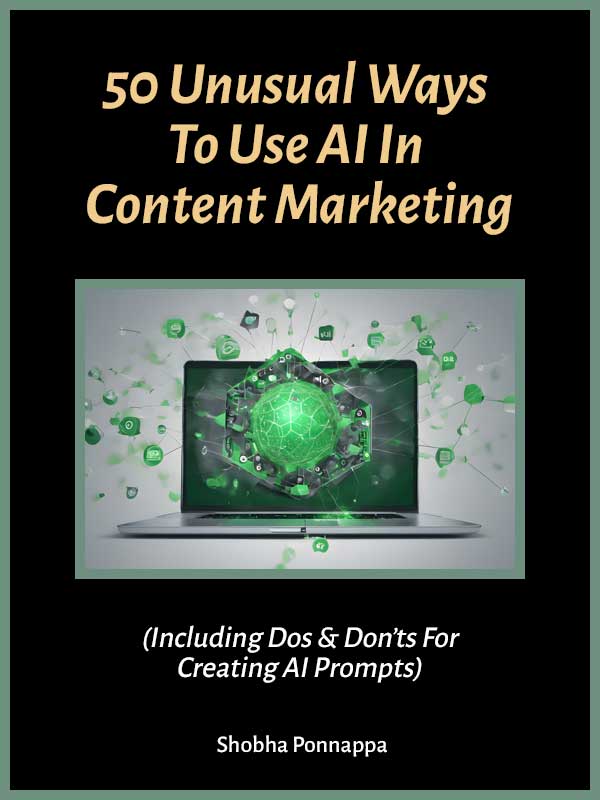
Content creators face the challenge of maintaining engagement while efficiently managing their content output. The key lies in mastering the art of repurposing content, transforming a single piece into multiple formats tailored for various platforms.
This approach not only maximizes reach but also optimizes resource use.
However, to truly stand out, it’s crucial to blend conventional methods with innovative strategies.
A balance of tried-and-true techniques and creative, unconventional twists can elevate your content, ensuring it resonates with diverse audiences while retaining its original essence and impact.
Content repurposing involves taking existing content and reformatting it into various types to suit different platforms and audiences. This strategy extends the life and reach of original content, making it more versatile and accessible.
By repurposing, a single blog post can become a podcast episode, a series of social media posts, an infographic, or even a webinar. This approach is highly efficient, saving time and resources while ensuring consistent messaging across channels. It also boosts SEO efforts by creating multiple opportunities for audience engagement and backlink generation.
Importantly, repurposing allows for targeting different audience segments who prefer diverse content formats, thereby maximizing the impact of the original content.
Additionally, it offers a chance to update or refine the message, keeping it relevant and fresh. In content marketing, repurposing is not just a convenience; it’s a strategic tool for amplifying reach, enhancing engagement, and reinforcing brand presence in a crowded digital landscape.
Repurposing content with smartness hinges on blending proven methods with unconventional ideas, a principle central to my “Unusual By Strategy” forte. This approach begins with traditional content repurposing tactics like transforming blog posts into infographics or podcasts, ensuring accessibility across different platforms and audiences.
However, the essence of this strategy lies in integrating offbeat ideas that set your content apart. This could involve creating interactive quizzes from educational content, or using augmented reality to bring static infographics to life, offering an immersive experience.
Such strategies not only capture attention but also foster deeper engagement. By infusing these novel elements, content transcends mere information dissemination, becoming a memorable and impactful experience.
This dual approach of conventional wisdom and innovative experimentation ensures content not only reaches a wider audience but also makes a lasting impression, cementing a brand’s unique presence in a crowded digital space.
Leveraging my 40+ years’ experience as a Brand Content Strategist with a penchant for the unusual, I have crafted eight ideas that blend time-tested approaches with creative twists for efficiently repurposing content across platforms. These ideas not only utilize proven methods to maximize content reach and engagement but also incorporate innovative elements that amplify their effectiveness.
By intertwining the reliability of conventional strategies with the freshness of unconventional tactics, these ideas are designed to ensure your content not only achieves widespread visibility but also delivers a unique and memorable experience to your audience, reinforcing your brand’s distinctive presence in the digital realm.

Efficient content repurposing starts with identifying your most successful core content pieces, a cornerstone in content marketing strategy. This involves analyzing your content repository to pinpoint pieces that have garnered significant engagement, be it through high traffic, social shares, or audience interaction.
For instance, imagine a blog post about ‘Innovative Gardening Techniques’ that received considerable attention and positive feedback. This piece becomes a prime candidate for repurposing.
It could be transformed into a series of short how-to videos for social media, an infographic summarizing key points for Pinterest, or a detailed podcast episode discussing each technique. The rationale behind this approach is to leverage already proven content, ensuring that the time and effort invested in repurposing yields maximum returns.
By focusing on content that resonates with your audience, you not only maintain engagement but also reinforce your authority in your niche, creating a cohesive and impactful content marketing strategy across various platforms.

Consider the idea of “Audience-Driven Content Evolution.” This unusual enhancement involves inviting your audience to directly contribute to the evolution of your core content. Once you’ve identified a successful piece, like the aforementioned blog post on ‘Innovative Gardening Techniques,’ engage your audience further by asking them to share their own gardening experiences or challenges related to the topic.
This could be through social media comments, email responses, or a dedicated forum. Then, integrate these real-life examples and solutions into the original content when repurposing it. This approach not only refreshes the content but also makes it deeply relatable and continuously evolving, driven by actual user experiences and interactions.
Mastering the art of content repurposing necessitates a deep understanding of each platform’s unique characteristics and audience preferences, a fundamental aspect of content marketing. For example, a comprehensive research report might perform exceptionally well on LinkedIn, attracting professionals seeking in-depth insights.
However, the same content might need a different approach on Instagram, where visuals and brevity are key. Here, the report could be distilled into eye-catching infographics or short, engaging video snippets highlighting key facts.
Similarly, Twitter (now X) could be utilized to share bite-sized, thought-provoking statistics from the report, sparking conversations and driving traffic back to the full content. This strategy ensures that the essence of the original content is not only preserved but also optimized for each platform’s audience, increasing engagement and reach.
Thus, understanding and adapting to each platform’s requirements is not just about format changes but about effectively communicating the same message in diverse, platform-specific ways that resonate with different audience segments.

Consider the idea of “Platform Personality Mimicking.” This unusual enhancement involves not just understanding but actively mimicking the unique ‘personality’ or ‘vibe’ of each social media platform. For the research report on ‘Innovative Gardening Techniques,’ this could mean adopting a more formal, business-like tone on LinkedIn, highlighting the economic and environmental benefits of the techniques.
On Instagram, transform this content to mirror the platform’s visual and casual style, perhaps using vibrant images of gardens with quick, catchy captions. On Twitter, adopt a witty, concise approach, focusing on surprising statistics or quick tips. This method goes beyond basic adaptation, ensuring your content doesn’t just fit in but actively speaks the language of each platform’s audience.
Breaking down larger content into micro-content is a strategy that enhances the accessibility and appeal of complex information, a critical aspect in content marketing.
Consider a comprehensive whitepaper on sustainable energy solutions. While the whitepaper offers in-depth knowledge, it’s lengthy and may not engage all segments of your audience. By segmenting it into smaller, more digestible pieces, each aspect of sustainable energy can be highlighted individually.
For instance, sections of the whitepaper can be transformed into a series of blog posts, each focusing on a different sustainable energy source. Short, informative videos could be created for social media, capturing key points in a visually engaging format. Infographics can summarize statistics and data, making them ideal for platforms like Pinterest or Instagram.
This method not only makes the content more palatable for diverse audience preferences but also extends its reach across multiple platforms, ensuring a broader impact and engagement.

Consider the idea of “Interactive Micro-Content Series.” This unusual enhancement involves transforming segments of larger content into an interactive series, where each piece encourages audience participation. For the whitepaper on sustainable energy solutions, this could mean creating a series of interactive social media posts or quizzes. Each post or quiz could focus on a different aspect of sustainable energy, inviting the audience to share their opinions, experiences, or even vote on their preferred energy sources.
This approach not only breaks down complex information into engaging, manageable parts but also fosters audience interaction and investment in the content. By turning passive readers into active participants, the content becomes a dynamic conversation, enhancing engagement and understanding of the topic.
Repurposing content into diverse formats is a key strategy to maximize its reach and impact. For example, a detailed article about the benefits of a plant-based diet can be transformed into a variety of formats to appeal to different audiences and platforms.
An infographic highlighting key statistics and benefits can capture attention on visual platforms like Instagram and Pinterest. The same content can be adapted into a podcast episode, discussing the topic in an engaging, conversational manner, ideal for auditory learners and busy individuals who prefer listening to content.
Additionally, the article’s main points can be condensed into a series of tweets or LinkedIn posts, perfect for sparking discussions and sharing bite-sized information.
This approach not only extends the life of the original content but also taps into different learning styles and preferences, ensuring that the message reaches and resonates with a wider audience, a critical goal in effective content marketing.

Consider the idea of “Augmented Reality Storytelling.” This unusual enhancement involves transforming traditional content into immersive augmented reality (AR) experiences. Take the example of the article on the benefits of a plant-based diet. By using AR technology, readers can engage with the content in a more interactive way.
Imagine pointing a smartphone at the article and seeing statistics pop up in engaging 3D graphics, or virtual tours of plant-based diets in different cultures around the world. This not only makes the content more engaging and memorable but also leverages cutting-edge technology to offer a unique, interactive experience that goes beyond traditional repurposing methods, adding a fresh and modern dimension to the content.
Updating, upgrading, or refreshing old content is a strategic move in content marketing, ensuring that your material remains relevant and continues to provide value over time. Consider a blog post written a few years ago about social media marketing trends.
The digital landscape evolves rapidly, and what was trending a few years ago might now be outdated. By revisiting this post, updating statistics, incorporating new trends like TikTok marketing, and perhaps adding a section on recent algorithm changes, the content becomes current and more valuable to your audience.
This process not only revitalizes old content but also strengthens SEO, as search engines favor updated, relevant content. Moreover, refreshing old content is more resource-efficient than creating new content from scratch, while keeping your message consistent and allowing you to maintain a strong presence in your area of expertise.
This approach is particularly beneficial for evergreen topics, where the core idea remains valuable but needs to be presented in a contemporary context.

Consider the idea of “Interactive Timeline Integration.” This unusual enhancement involves transforming updated content into an interactive timeline, showcasing the evolution of the topic. Applying this to the example of the social media marketing trends blog post, the timeline could visually display the progression of trends over the years.
Readers could click on different points in the timeline to see how strategies have changed, with the latest updates for the current year highlighted. This not only refreshes the content with updated information but also provides an engaging, interactive historical perspective, allowing readers to see the journey of social media marketing trends over time and understand the context of the current landscape.
Cross-linking content between platforms is a vital strategy in content marketing, enhancing visibility and reinforcing the interconnectedness of your digital presence.
For instance, if you create a video on YouTube about innovative gardening techniques, you can cross-link it to a detailed blog post on your website covering the same topic in depth. Similarly, snippets of the video can be shared on Instagram or Twitter, with links directing viewers to the full YouTube content or blog post.
This not only drives traffic between platforms but also provides your audience with multiple ways to engage with your content, depending on their preferred platform or content format. Additionally, cross-linking aids in SEO by creating a network of backlinks, increasing the likelihood of your content being discovered.
It’s about creating a cohesive content ecosystem where each piece, regardless of its format or platform, is interlinked, offering a comprehensive and enriched experience to your audience.

Consider the idea of “Narrative Weaving.” This unusual enhancement involves creating a story that spans across multiple platforms, with each piece of content serving as a chapter in the narrative. Applying this to the example of innovative gardening techniques, you could start the story with a blog post outlining the basics, then direct readers to an Instagram post showing a time-lapse video of a garden transformation.
Next, a podcast episode could delve into interviews with gardening experts, with links back to the blog for more detailed information. This method turns cross-linking into a compelling journey, encouraging the audience to follow the entire story across different platforms, thereby deepening engagement and making the content exploration an adventure in itself.
Maintaining consistent branding across platforms is essential in establishing a recognizable and trusted presence in content marketing. Imagine a brand that specializes in eco-friendly products.
On their blog, they use a calm, informative tone, and a green and earthy color scheme to reflect their commitment to sustainability. This branding should be coherent across all platforms.
For instance, their Instagram posts should feature similar color schemes and themes, their Twitter feed should echo the same tone and messaging, and even their YouTube videos should maintain this visual and tonal consistency. This uniformity ensures that no matter where the audience encounters the brand, the core message and aesthetic are immediately recognizable.
Consistent branding not only strengthens brand identity but also builds trust and reliability in the eyes of the audience. It’s about creating a seamless brand experience, where each platform is a different chapter of the same story, providing a cohesive and harmonious brand journey for the audience.

Consider the idea of “Sensory Branding Synthesis.” This unusual enhancement involves integrating consistent sensory elements across platforms to create a multi-sensory brand experience. For a brand specializing in eco-friendly products, beyond visual consistency in color and design, this could include the use of nature-inspired sounds in video content and podcasts, and the incorporation of earthy, tactile imagery in visual posts.
On Instagram, posts could feature nature sounds in the background, while blog posts might include high-quality images that evoke a sense of touch, like close-ups of natural textures. This approach not only maintains visual and tonal consistency but also adds a layer of sensory engagement, making the brand experience more immersive and memorable across different platforms.
Measuring and analyzing content performance is crucial for understanding the effectiveness of your repurposing strategies and making informed decisions in content marketing. For instance, after repurposing a well-received blog post about healthy eating habits into a series of Instagram posts, a YouTube video, and a podcast, it’s important to track metrics specific to each platform.
This could include website traffic from social media links, engagement rates like comments and shares on Instagram, view counts on YouTube, and download numbers for the podcast. Analyzing these metrics reveals which formats and platforms are most effective in engaging your audience and spreading your message.
This data-driven approach allows for fine-tuning future content strategies, ensuring resources are focused on the most impactful activities. It also provides insights into audience preferences and behaviors, enabling the creation of more targeted and resonant content.
Regularly analyzing content performance is essential not just for measuring success, but for continuous improvement and adaptation in a dynamic digital landscape.

Consider the idea of “Emotional Response Analysis.” This unusual enhancement involves going beyond traditional analytics to measure the emotional impact of your content. Using tools that analyze audience reactions and comments for sentiment, you can gauge the emotional resonance of your repurposed content.
For instance, after transforming a blog post about healthy eating into various formats across platforms, employ sentiment analysis to understand how your audience feels about the content. Are they inspired, amused, or informed? This deeper insight can guide you in tweaking the tone and approach of your content across different platforms, ensuring not only engagement but also a strong emotional connection with your audience.
Efficient repurposing maximizes reach and engagement: By creatively repurposing content into various formats suited for different platforms, you extend the lifespan and reach of your original message, engaging a broader audience and reinforcing your brand’s presence across the digital landscape.
Balancing consistency with innovation: Maintaining consistent branding and messaging across platforms, while incorporating innovative strategies like sensory branding and emotional analysis, ensures a cohesive yet dynamic brand experience that resonates deeply with your audience.
Data-driven adaptation is crucial: Regularly measuring and analyzing the performance of repurposed content is essential. This not only helps in understanding what resonates with your audience but also guides future content strategies, allowing for continuous improvement and more effective audience engagement.

"As a Content/Brand Specialist, and SEO/UX Writer, I can help transform your brand's online presence. I can lift it with innovative ideas to take it to an enviable position. Let's collaborate to create a captivating brand story, engage your audience, boost your online visibility, and increase your ROI. Take the next step towards your brand content success and contact me today."
Shobha Ponnappa
I Bring You:
Content Marketing That’s “Unusual By Strategy” … Tips, Tricks, Tactics, Techniques, Trends, Training.
Get my weekly ContenTracker Newsletter packed with loads of content marketing ideas – proven and unusual.
Get a free download of my ebook on “50 Unusual Ways To Use AI In Content Marketing” … and transform your success.

Just fill in the form to join my community … we have big and small brands for company. You’ll stay on the speedway to growth.
KEY TOPIC CATEGORIES COVERED ON THIS SITE:
COPYRIGHT © 2024. SHOBHAPONNAPPA.COM. ALL RIGHTS RESERVED.

Just fill in this form and get this awesome ebook in your email inbox. Plus … each week you’ll receive my ContenTracker Newsletter that brings you tips, tricks, tactics, techniques, trends, and training on the latest in content marketing.